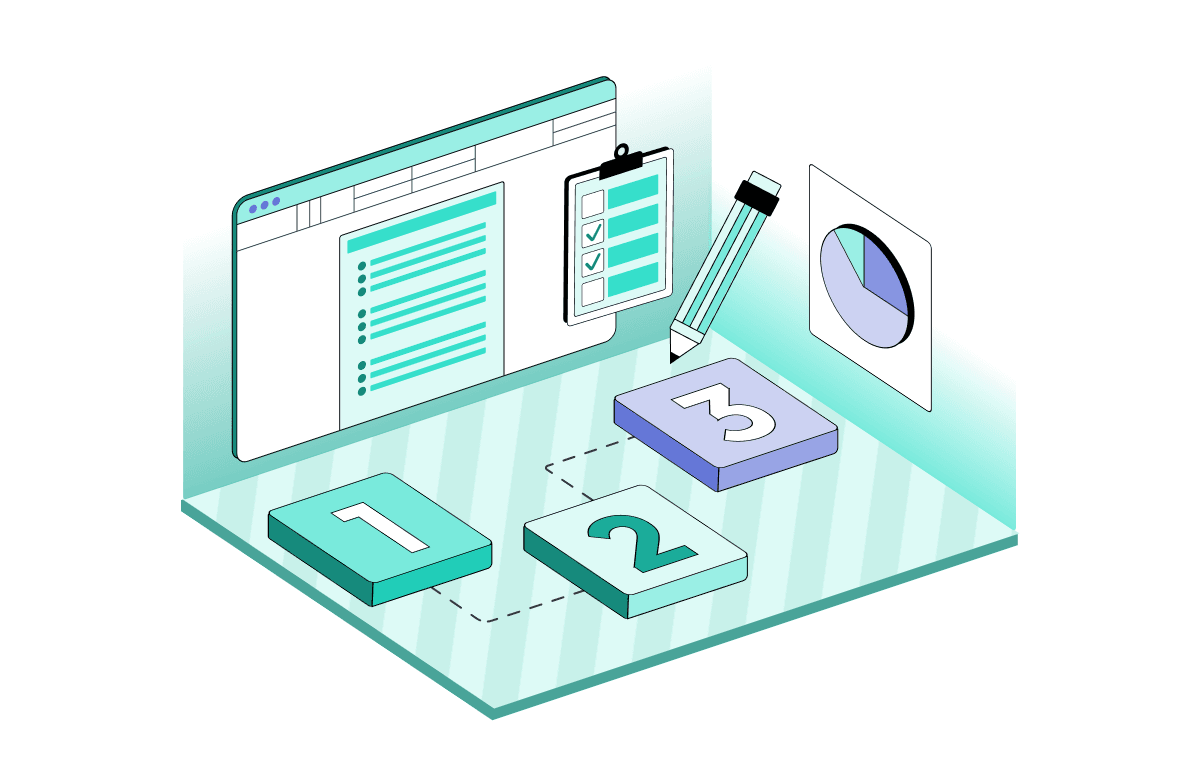Updated Nov 13, 2024 7 min read
Step-by-Step Creating Test Plan: All Needed Questions and Tools
The test plan should be like a blueprint of your project and serve as an example for the test team. But let's move from words to creating test plan and consider step-by-step what needs to be done and what steps to take to plan software testing.

You already know what a test plan and test strategy in software testing are, and you already understand that the creation of a test plan plays an important role in quality software testing. The test plan should be like a blueprint of your project and serve as an example for the test team. But let's move from words to creating test plan and consider step-by-step what needs to be done and what steps to take to plan software testing. You can also read our article about how to write a test plan for software testing for comprehensive guidance on developing a robust testing strategy.
Describe the Creating Test Plan Goals
Every test plan software testing plan begins with choosing the appropriate goals. The goals should be stated as plainly as possible to maximize their value. You should also confirm if the objective is doable. It will aid the team in navigating the procedure and determining the end goal. You might attempt to concentrate on the following inquiries while you complete this step:
- What is the test supposed to measure?
- What objectives exist for the testing process?
- What outcomes from the tests are you anticipating?
Let's imagine this situation - you need to test a mobile application. Objective: We will choose mobile application verification as our task. Goals: Now, our task will be to check the functionality of the application so that the app works correctly. Also, do not forget about the requirements of the client. Results of the testing: We will consider the identification of all bugs and problems in the application and their further correction as a good result.
Determine the Scope
The breadth of the testing strategy is mostly determined by the type of project and its complexity. It is critical to examine the type of software testing process required for your project. Additionally required are the requirements and the amount of work that must be completed. Here are some questions to consider in this paragraph:
- What parts of the project should be tested?
- What are the different scenarios that need to be tested?
- What product requirements need to be checked?
Continuing with the mobile application example, let's answer the questions. Parts of the project: Payment methods, customer account, customer service. Scenarios: Registration, account login, internal purchase, and card binding. Product requirements. Compatibility, usability, accessibility.
Define the Testing Approach
Defining the testing approach is crucial for the project. It will help you choose the methods and tools that will be used to test the test plan software. You should keep in mind that the approach to testing should be aligned with the goals of testing. Some of the questions that need to be answered at this stage are:
- What testing approach will be implemented?
- What testing technique will be supposed to apply?
- What are the testing tools that will be used?
Examples:
Testing approach | Agile testing |
|---|---|
Techniques | Functional testing, regression testing, and usability testing. |
Testing tools | TestComplete, Espresso, Xcode Simulator, AWS Device Farm. |
It is worth talking about the test plan software for QA testing in more detail. Testers use a variety of apps to test mobile applications, depending on the specific needs and requirements of the project (you can also read our article about QA documentation for comprehensive insights into the importance of documenting your quality assurance processes).
The types of these instruments also differ in their purpose:
- Emulators and Simulators: these tools allow you to test and simulate various operating systems without a physical device.
- Mobile Device Clouds: these services give users remote access to functional mobile devices, enabling testers to run tests across several platforms and devices at once.
- Automated Testing Tools: these tools automate the testing process using scripts and test scenarios, which saves time and effort by eliminating the need to execute repetitive test cases.
- Manual Testing Tools: these comprise tools for taking screenshots and filming the app's performance, as well as bug-tracking and defect-management tools.
- Network Testing Tools: The app’s functionality can be tested under various network environments using these tools, which enable testers to simulate various conditions, such as sluggish or unstable connections.

Testing Resources
Understanding the required resources for a project is required. You need to acknowledge in advance what kind of test plan software or hardware you need, as well as what data will be used and how much time you have for testing or what abilities you need. A successful project test plan document needs to clarify what exactly resources it requires. Use questions like these for this section:
- Who will be part of the test team?
- What is the testing environment required for the testing process?
- What are the testing tools required for the testing process?
Team | Test manager, test analyst, test engineers. |
|---|---|
Environment | Mobile devices, test servers, and test data. |
Tools | Appium, Xamarin, UITest, Robotium. |
Schedule
The schedule is necessary for the correct allocation of time for testing. The time should be distributed as efficiently as possible so that each testing stage passes quickly and with high quality. Start with a clear understanding of the project scope and objectives, and identify all the testing activities required to achieve them. Break down the testing activities into smaller, manageable tasks and estimate the time required for each task. Here are the questions to be answered:
- What is the timeline for the testing process?
- What milestones need to be achieved during the testing process?
- What is the estimated time required for each milestone?
Examples:
Timeline | Estimated time |
|---|---|
Milestones | One month |
Estimated time | One week for exploratory testing, two months for regression testing, and one week for UX/UI testing. |
Testing Deliverables
The results of your testing determine how documents and reports will look during testing. The testing deliverables should include only the required information about the testing process. Here are the questions you will need:
- What will be produced as testing deliverables?
- What format are the deliverables from the testing?
- What does the testing deliverables' content consist of?
Examples:
Produced | Test cases, test scripts, and a test summary report. |
|---|---|
Format | Word document, Excel spreadsheet, HTML format. |
Content | Testing approach, testing schedule, test cases, test results. |
Identify the Testing Risks
Plan software testing is almost ready. And it is worth considering the testing risks. If your testing passes without any problems, this is certainly good. But it is even better to foresee the risks. All the troubles will cease to be problems since you were ready for them. These questions will help you with this point:
- What potential risks could affect the testing process?
- What risk prevention methods do you need to apply?
Examples:
Potential risks | Incomplete test coverage, communication issues, and time constraints. |
|---|---|
Prevention methods | Prioritize testing areas, ensure effective communication, and adjust the testing schedule. |
Conclusion
Now you know every necessary step to creating a test plan for software testing. You also learn how to define the objectives, scope, testing approach, testing resources, testing schedule, testing deliverables, and testing risks in a test plan. You can also read about the software QA process in our article to better understand how we ensure the quality and reliability of software products.
When working on a new project, you will know what issues to pay attention to at each stage. Another vital component emphasizes the need for a comprehensive test plan document that provides a roadmap for the testing process and serves as a reference for the test team. And always remember that a well-designed software test planning helps identify potential issues early and provides clear direction for the testing process, ultimately leading to a more efficient and effective testing cycle. Our team is here to assist you with any questions you may have about our services or your project. Talk to our team and let us help you achieve your goals. We look forward to hearing from you!
Comments
There are no comments yet. Be the first one to share your opinion!
For 8 years, we have helped more than 200+ companies to create a really high-quality product for the needs of customers.
- Quick Start
- Free Trial
- Top-Notch Technologies
- Hire One - Get A Full Team
Was this article helpful to you?
Looking for reliable Software Testing company?
Let's make a quality product! Tell us about your project, and we will prepare an individual solution.
FAQ
A test plan is a detailed document that outlines the strategy and scope for testing a particular software product or system.
A test plan ensures systematic and comprehensive testing, provides clarity on testing objectives, and acts as a reference guide for all stakeholders involved.
Whenever there are significant changes in the software, requirements, or testing environment, it's a good idea to update the test plan.
Success criteria should be based on requirements, desired functionality, and industry standards. Examples include no critical bugs, meeting performance benchmarks, and achieving user acceptance.
It's essential to document, communicate, and prioritize these risks. Strategies should be developed to mitigate or manage them during the testing phase.




